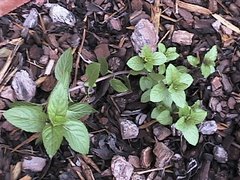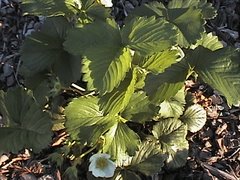Seed Starting Tips
By Yvonne Cunnington
Starting your own plants from seed is a very satisfying project if you're itching for spring. Growing flowers and vegetables from seed isn't all that difficult if you follow these simple guidelines:
Enjoy browsing and ordering from the seed catalogues and web sites, but don't start your actual sowing too early. It's tempting to get started as soon as seeds arrive, but don't sow too soon or your plants will be leggy and overgrown long before it's safe to transplant them outside. If the seed packet recommends sowing four to six weeks before the last frost date, it's better to go with the four-week, rather than the six-week date.
Another pitfall is sowing more than you need. By all means, sow a little extra to make sure you get enough plants, but thin your seedlings to a manageable number. Many leftover seeds are viable for several years if stored in a dry, cool, dark place.
Always use a sterile seed-starting mixture, available from garden centers. Don't use garden soil, which contains fungi and bacteria that can kill fragile seedlings and do not reuse old potting soil for seed-starting.
Follow directions on the seed packet with regard to light and soil temperature. Some seeds sprout in light, others in darkness. Some seeds do best in warm conditions, so invest in a heat mat for seed starting, or put your seed-starting flat in a warm spot, such as on top of the refrigerator. Most young plants grow best at day-time temperatures between 70 to 75ºF (21 to 24ºC) and night-time temperatures between 55 to 65ºF (13 to 18ºC).
Don't over water new seedlings. Over watering can lead to fungal diseases that kill off tiny new plants. Water sparingly, but frequently.
Give newly sprouted seeds enough light. A bright window will do, but grow lights are better.
When seedlings have two sets of true leaves (the first leaves are called seed leaves or cotyledons), start fertilizing once a week with half-strength liquid plant starter or fish emulsion fertilizer.
Harden off young plants before you plant them out into the garden. Cool-season annuals such as pansies and snapdragons should be hardened off several weeks before tender, heat-loving ones such as impatiens or tomatoes. Set your plants outside in a shady, sheltered spot for at least a week or two before transplanting into the garden. Give them half a day outdoors at first, and gradually leave them out longer, slowly moving them into sunnier and windier areas to get them used to life in the real world.
Yvonne Cunnington is a garden writer and the author of Clueless in the Garden, a guide for beginner gardeners. For more information on seed-starting see http://www.flower-gardening-made-easy.com/Seeds.html and http://www.flower-gardening-made-easy.com/seedlings.html For more gardening tips, visit Yvonne's website at http://www.flower-gardening-made-easy.com.
Article Source: http://EzineArticles.com/?expert=Yvonne_Cunningtonhttp://EzineArticles.com/?Seed-Starting-Tips&id=129271
Subscribe to:
Post Comments (Atom)






No comments:
Post a Comment